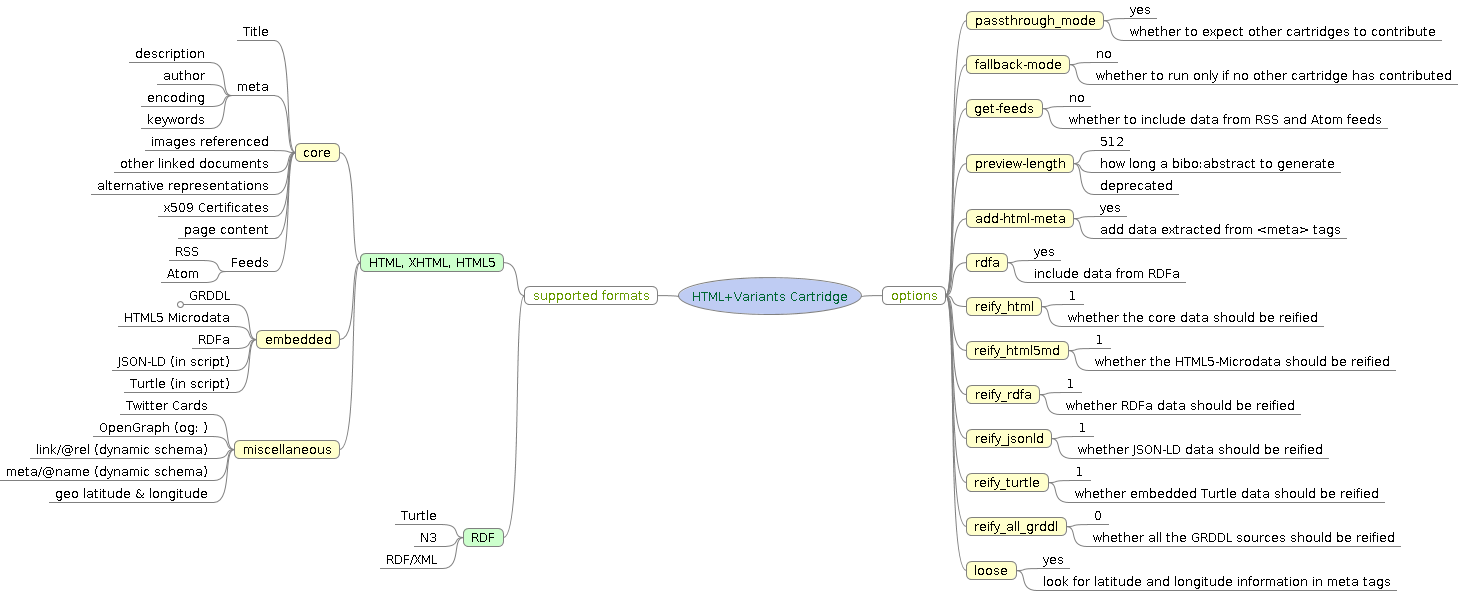Virtuoso HTML+Variants Cartridge Configuration
Overview
The HTML and Variants extractor cartridge handles various XML document formats including HTML, XHTML and pure RDF (XML, Turtle, N3).
RDF sources are ingested directly.
Sources that look like HTML are passed through HTML Tidy before further extraction can take place.
Many dialects for embedding microdata (collectively known as "data-islands") are supported.
Certain well-known domain-specific standards (such as Twitter Cards) are also supported.
Core HTML
At its core, the HTML+Variants cartridge identifies the following aspects of a webpage:
- Title and other well-known data in <meta> tags such as description, author, keywords, encoding, etc
- images referenced
- links to alternate forms of the current document
- links to other referenced documents
- x509 Certificate fingerprints
- the page content
- any RSS or Atom feeds it finds
In a second extraction, the following are also supported:
- Twitter Cards
- OpenGraph markup (og: prefix)
- any link@rel becomes a predicate
- any meta@name becomes a predicate
Because the mapping between an HTML document and a logical primary entity is not always clear, there is an option whereby
- any mention of latitude and longitude in a meta tag is extracted
Data Islands
There are many ways in which an HTML document can contain embedded data, termed data-islands.
Because of its significance, HTML5 Microdata is regarded as an island, although it is processed along with other formats in the GRDDL loop - a second island encompassing:
- AB Meta
- BSBM
- Dublin Core
- eRDF
- geoURL
- Google Base
- hAudio
- hCalendar
- hCard
- hListing
- hNews
- hProduct
- hRecipe
- hResume
- hReview
- hReview-aggregate
- HR-XML
- Microsoft XML Spreadsheet 2003
- Ning Metadata
- relLicense
- Slidy
- Word 2003 XML Document
- XBRL
- XDDL
- XFN Profile
- XFN Profile2
- xFolk
Recent W3C standards have proposed the use of the HTML <script type="text/turtle">...</script> tag for storing Turtle RDF triples.
Relatedly, Google promote the use of the same HTML <script type="application/ld+json">...</script> tag for storing data in JSON-LD format.
Reification
Data in each of the above islands can be reified (default: enabled apart from the plethora of GRDDL microformats), by which for every statement extracted, an rdf:Statement entity is created summarizing the statement's subect, predicate and object/value along with a pointer to the data-island whence it came.
Enabled by default, this reification can be disabled selectively for
- HTML core + meta extraction (together)
- RDFa data
- Turtle-in-script
- JSON-LD-in-script
- all the supported GRDDL formats
- HTML5-Microdata
Passthrough Mode
Previously, the HTML+Variants cartridge used to be regarded as a fall-back, to be invoked in cases where no other extractor cartridge could handle the document.
This has changed; by default, the HTML cartridge is now the first to be invoked; this requires its exit-status be set to permit control to flow into other cartridges.
If the HTML cartridge detects another enabled cartridge that might contribute to the data, it assigns its output to the container entity representing the HTML document; in cases where no other cartridge is likely, it makes statements using the primary entity URI as a subject instead.
If you wish to move the HTML cartridge back to the bottom of the list, you should also change the passthrough back to `no'.
Options
The HTML+Variants cartridge supports the following options:
- passthrough_mode=yes - whether to expect other cartridges to contribute
- fallback-mode=no - whether to run only if no other cartridge has contributed
- get-feeds=no - whether to include data from RSS and Atom feeds
- preview-length=512 (deprecated) - how long a bibo:abstract to generate
- add-html-meta=yes - add data extracted from <meta> tags
- rdfa=yes - include data from RDFa
- reify_html=1 - whether the core data should be reified
- reify_html5md=1 - whether the HTML5-Microdata should be reified
- reify_rdfa=1 - whether RDFa data should be reified
- reify_turtle=1 - whether Turtle data embedded in <script> elements should be reified
- reify_jsonld=1 - whether JSON-LD data embedded in <script> elements should be reified
- reify_all_grddl=0 - whether all the GRDDL sources should be reified
- loose=yes - look for latitude and longitude information in meta tags
